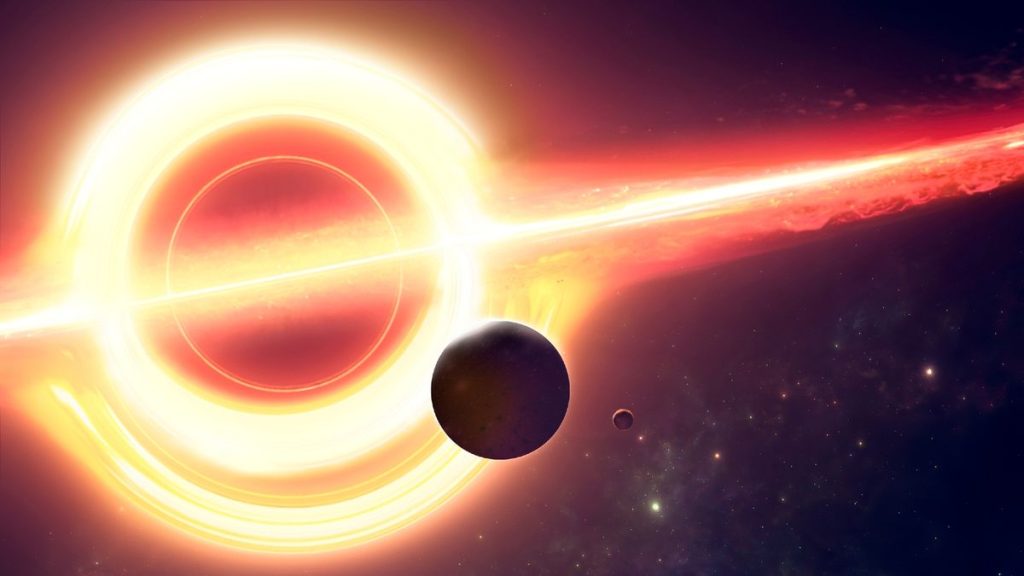An artist’s interpretation of a black hole’s accretion disk might look like. (Image credit: Getty Images)
For the first time ever, scientists have measured the exact size of the disk of matter swirling around a supermassive black hole. The serendipitous finding could help expand our knowledge of how these cosmic juggernauts grow and how the galaxies that surround them evolve over time.
Accretion disks are massive swirling rings of superheated gas, dust and plasma that rotate around black holes or other enormous cosmic objects, such as pulsars. The disks around black holes are made from remnants of shredded stars, exoplanets and other matter that was ripped apart as it was pulled toward the event horizon — the point beyond which nothing, not even light, can escape the black hole’s gravitational pull. As accretion disks rotate, they emit a range of electromagnetic radiation including X-rays, infrared radiation, radio waves and visible light, making them the only part of a black hole that astronomers can detect.
Related: Do black holes really suck in matter?
Accretion disks are most clearly visible in the infrared spectrum. The spinning masses emit what researchers call a double-peak, which is a pair of energy spikes from excited hydrogen gas emitted by both halves of an accretion disk — the half that is spinning away from the observer and the half that is spinning toward them. These double-peaks originate from the edge of an accretion disk that is closest to the event horizon, which means they can show where the spinning disks start but not where they end.
But in a new study published Aug. 8 in The Astrophysical Journal Letters, researchers detected a second double-peak coming from the outside edge of an accretion disk surrounding the supermassive black hole III Zw 002, which is located more than 22 million light-years from Earth and is at least 400 million times the mass of our sun. Based on the pair of double-peaks they spotted, researchers calculated that the radius of the accretion disk around III Zw 002 is around 52.4 light-days, which is more than 9,000 times the distance from Earth to the sun.
This diagram shows how a standard infrared double-peak is produced by a black hole’s accretion disk. (Image credit: NOIRLab/NSF/AURA/P. Marenfeld)
The researchers had not been searching for the second double band around III Zw 002 when they made the find. Instead, the team was collecting data to confirm the presence of the accretion disk, which was first detected in 2003.
Researchers used the Gemini Near-Infrared Spectrograph (GNIRS) from the Gemini North telescope in Hawaii to capture the new data. GNIRS measures a slightly wider range of wavelengths than regular infrared light usually appears in and can detect emissions in different wavelengths simultaneously, which is what enabled the team to spot the second double-peak.
Related: First-ever close-up of a supermassive black hole sharpened to ‘full resolution’ by AI
At first, the researchers didn’t believe what they’ found, but it soon became apparent to them. “We reduced the data many times thinking it could be a mistake, but every time we saw the same exciting result,” study co-author Alberto Rodríguez-Ardila, an astronomer at the Canary Islands Astrophysics Institute, said in a statement.
The researchers believe the discovery could play an important role in helping to uncover the mysteries of supermassive black holes.
“The detection of such double-peaked profiles puts firm constraints on the geometry of a region that is otherwise not possible to resolve,” Rodríguez-Ardila said. This will enable researchers to observe the “feeding process and the inner structure of an active galaxy” for the first time, he added.
The team will continue to monitor the accretion disk around III Zw 002 to see how it grows over time.
This is not the only major breakthrough scientists have made in understanding accretion disks this year. In May, researchers revealed that they had created artificial accretion disks out of plasma in the lab for the first time ever. The fake rings only last for a fraction of a second but hint at how accretion disks are formed.

